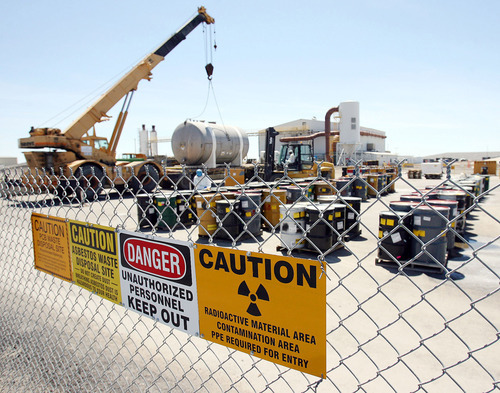This is an archived article that was published on sltrib.com in 2011, and information in the article may be outdated. It is provided only for personal research purposes and may not be reprinted.
EnergySolutions Inc. paid the state fine earlier this month for burying 23 barrels of too-hot waste at its Tooele landfill.
But, weeks after the Utah Division of Radiation Control received the $80,000 check to cover the fine, a touchy question remains.
Should state regulators require the nuclear waste company to dig up the waste?
Rusty Lundberg, director of Utah's Division of Radiation Control, said his office is reviewing the company's arguments that removing the greater-than-Class A waste would be too costly — in terms of time, money and worker and public health.
The division's goal, Lundberg said, is "to make sure that they are in compliance with [Utah's] Class A limits and that they stay in compliance."
Last fall, during an internal audit, EnergySolutions discovered that waste from 15 shipments over the past decade had been buried in its mile-square, low-level radioactive waste disposal site despite having higher concentrations of radioactivity than permitted under the site's license and Utah law.
The waste had come from cleanups at U.S. Department of Energy and National Aeronautics and Space Administration sites, and their burial prompted the $80,000 fine against Salt Lake City-based EnergySolutions and fines totaling more than $17,000 against the contractors that shipped it to Utah.
The national system for low-level radioactive waste — separate from the program that deals with high-level nuclear waste from reactors and bomb-making — specifies that Class A waste must lose most of its radiological hazard after 100 years. Class B and C waste, which loses most of its hazard in 300 and 500 years, respectively, was banned in Utah in 2005.
So, for the state, the question boils down to whether risk of leaving the waste buried where it is outweighs the risk of digging it up. Another risk: If it decides the waste should be left where it is in violation of Utah law, the state could open itself to the charge that its radioactive waste limits are flexible.
EnergySolutions notes in its April 7 report to Lundberg that its site was robust enough to contain the sort of waste contained in the 23 greater-than-Class-A barrels. It would be safer to leave the waste in place than it would to remove it, the company said in a 60-page evaluation of the alternatives The Salt Lake Tribune obtained under the Government Records Access and Management Act.
"Comparison of the impacts to worker doses and general public exposures from these two alternatives suggests that attempts to recover the errant waste be avoided," the report's executive summary concludes.
"The additional worker doses and general population exposures from waste recovery far exceed the negligible projected doses from increases to the future groundwater concentrations (which are estimated as zero, since the groundwater is not potable or usable)."
The summary concludes that removing the 23 barrels "conveys no corresponding benefit in terms of reducing general public and environmental impacts" and "does not compromise [the landfill's] ability to meet its performance objectives."
Meanwhile, it could cost as much as $2 million to dig up the waste. And the job could take as long as two years, the report said.
Lundberg said his agency has just begun analyzing the EnergySolutions report. He also noted that the state is trying to negotiate a "supplemental environmental project" with the company as part of the resolution of the case.
Meanwhile, four of the five contractors that were fined for sending the too-hot waste to Utah have resolved their violation notices with the state, said Lundberg.



